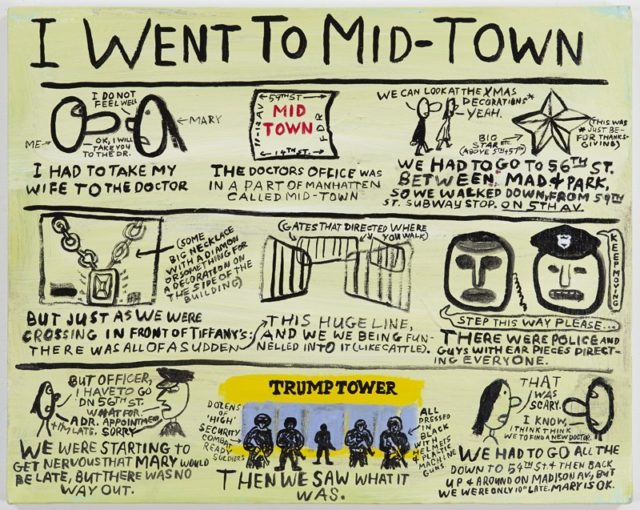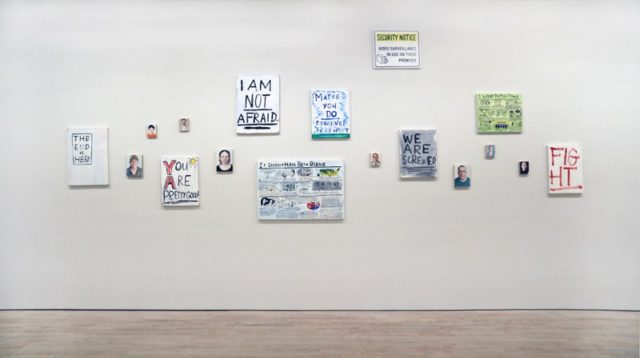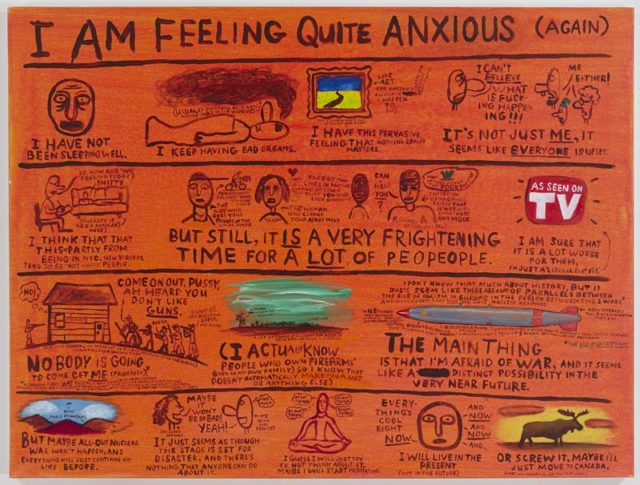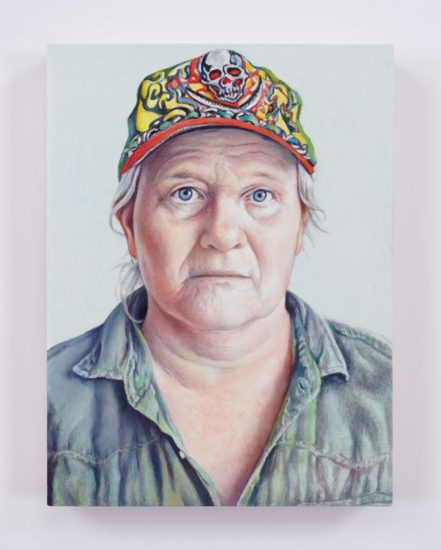
Jim Torok, “I Went to Midtown,” 2016, Acrylic on Canvas (Courtesy the artist and Pierogi, New York)
Jim Torok: The New Age Of Uncertainty
Pierogi
155 Suffolk Street
New York, NY
On view until February 12, 2017
The term echo chamber has been thrown around since Trump’s election. When applied by conservatives, it’s used mostly as an attempt to dismiss the alleged close-minded perspective of “coastal elites,” a critique with few merits, even if sometimes true.
The limitations of this critique are especially visible in Jim Torok’s current solo exhibition The New Age of Uncertainty at Pierogi.The work articulates progressive panic and anxiety due to our current political atmosphere through a series of text-based paintings and portraits. In many ways, the exhibition simply reflects back the liberal perspectives those in the New York art community already see daily on social media. This approach has some obvious weaknesses, namely preventing the show from landing a far-reaching political critique. Instead, the exhibition succeeds more as a portrait of a specific ideology and frantic psychological state.
The show’s title references the “Age of Uncertainty,” the rise of fascism between World War I and II. Addressing our own uneasy age, Torok presents a faithful snapshot of the unstable contemporary United States, as seen through the perspective of a New Yorker. Canvases, divided like storyboards, portray short vignettes of Trump’s America such as a harried attempt to maneuver through the security-filled block near Trump Tower. A series of text-based paintings, emblazoned with “Fight,” “I am not afraid,” and “Do not panic (yet),” would not look out of place at an anti-Trump march. And miniscule hyperrealistic paintings of fellow artists, looking vaguely worried, are scattered around the exhibition. It seemed all too familiar. In the days since Trump took office, I’ve seen similar looks plastered on my friends and colleagues’ faces, as well as my own.

Installation view of Jim Torok’s The New Age of Uncertainty at Pierogi (Courtesy of the artist and Pierogi, New York)
Some curatorial and artistic decisions, primarily the inclusion of disparate bodies of work, distracted from the show’s interpretation of a population’s frenzied mindset. Take, for example, Sky Diptych, which features a literal rendering of a partly cloudy sky. Filling a large expanse of wall, the awkward placement and sheer size of the serene skyscape limited the possibilities of analysis. It could only be understood as a simplistic respite from confronting our national nightmare. Rather than calming, though, it is a pointless diversion.
Perhaps, unsurprisingly, the most relevant works feature direct and honest depictions of Torok’s experiences under Trump. For instance, Torok’s storyboard painting I’ve Been Feeling Quite Anxious Again takes viewers on a roller coaster ride through Torok’s emotions, neuroses and fears for the future. Completed on a blinding, bright orange canvas, the painting begins with the statement: “I have not been sleeping well again.” From there, the narrative continues in a flurry of tiny text and cartoonish drawings, reminiscent of William Powhida’s work (though Torok’s It Should Have Been Bernie likely draws the most obvious comparison). Rendered in a frenetic hand emphasizes Torok’s frazzled nerves, it’s enough to make any viewer need a Xanax.

Jim Torok, “I Am Feeling Quite Anxious Again,” 2016, Acrylic on Canvas (Courtesy of the artist and Pierogi, New York)
But, it’s not all doom and gloom. Torok finds some moments of dry humor in the darkness. The piece concludes, “Screw it, maybe, I’ll just move to Canada.” Above this phrase, Torok paints a silhouette of a moose behind a yellow sky. Here, Canada is the hilariously stereotypical expat paradise, often idealized by left-leaning Americans.
I related to Torok’s impulse to flee the country, as well as many of his other statements scattered around the cluttered piece. This immediate agreement with Torok’s views, though, made me feel conflicted. I wondered: what was I getting out of the painting other than a confirmation of my own views? Was I being challenged in any way?
The answer is no. Yet, I did find some solace in the work’s relatability. While an uber-sensitivity to the charge of echo chambers after months of discussion on the topic gave me pause, maybe the show’s power as a portrait rather than a sweeping political statement shouldn’t be brushed off as simply superficial. Instead, it could offer a glimpse at the importance of finding a community of like-minded people.

Jim Torok, “Jennifer,” 2016, Oil on panel (Courtesy of the artist and Pierogi, New York)
This conclusion would feel facile if it were not for the fact that the exhibition itself seemed to be about showcasing this type of community. This appears most obviously in his series of miniature portraits of friends, colleagues and neighbors from both New York City and Upstate New York. These tiny paintings depict a front-facing figure with a disarmingly direct gaze. Some of Torok’s chosen subjects are fairly well-known including artist and critic Walter Robinson and Mickalene Thomas, while others are less recognizable. Torok represents a range of subjects from Margaret, a punky woman with heavy black eyeshadow and a shaved head, to Jennifer, who wears a workman’s shirt and a trucker hat adorned with a flaming skull. These paintings are striking in their diversity and inclusivity.
While individually each piece is engaging with its detailed and sympathetic representation of the figure, the works, taken as a whole, portray an artistic community or, at least, Torok’s own self-made one. By presenting this collection of friends, his series and, in fact, the entire show reveals that finding a group of like-minded people is essential for both survival and political mobilization. And, at a time when being glued to the news can be so isolating, this reminder that we aren’t and shouldn’t be alone in this struggle seems not only meaningful, but necessary.


Comments on this entry are closed.